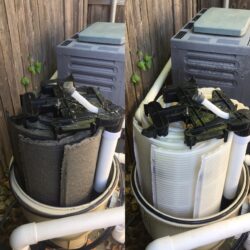How Often Should You Backwash Your Pool?
Maintaining pristine pool water can often feel like a daunting task, and the question of how frequently to backwash the filter is one many of us have grappled with. Trust us, you’re not alone.
Through experience and working on many pool over the years, we’ve unlocked the importance of regular maintenance for that crystal-clear water every pool owner dreams of. This blog is your go-to guide for understanding the perfect timing and recognizing the tell-tale signs that it’s time for a backwash.
So, stay tuned as we dive into tips that will alleviate all your pool-related concerns!
Explanation of Backwashing
Transitioning from understanding the importance of clean pool water, we dive into explaining backwashing, a crucial step in pool maintenance. Backwashing is the process where we reverse the flow of water through the filtration system to remove trapped debris and contaminants from the filter media.
This method cleans out everything that hampers your filter’s efficiency, ensuring that your pool remains crystal clear.
We use different settings on sand filters or DE (diatomaceous earth) filters during this procedure. These settings include ‘Filter’, ‘Backwash’, ‘Rinse’, and others. The aim here is to direct dirty water to the waste line instead of sending it back into the pool.
It’s essential to monitor the pressure gauge closely because once it reads 8-10 PSI over its starting level, it signals us that it’s time for a backwash.
Determining the Frequency of Backwashing
Figuring out how often to backwash your pool doesn’t have one simple answer. Several factors, including filter pressure and the clarity of your pool water, play huge roles in this decision.
Factors influencing backwashing schedule
We all understand the importance of keeping our pool water clean and ensuring our pool equipment runs smoothly. One key process in achieving this is backwashing, but knowing when to do this can be tricky.
Numerous factors play a role in determining the optimal schedule for backwashing your pool filters.
Here’s a breakdown:
- Filter Pressure: Keep an eye on the psi (pounds per square inch) reading on your pool filter’s pressure gauge. A rise of 8-10 psi over the normal operating pressure typically signals it’s time to backwash.
- Pool Usage: More swimmers mean more debris and contaminants in the water, requiring more frequent backwashing to maintain clarity and sanitation.
- Surrounding Environment: Heavy rains, high water levels, and nearby foliage can introduce additional debris into your pool, thus affecting how often you need to backwash.
- Type of Pool Filters: Sand and DE filters have different maintenance needs. Sand filters usually require less frequent backwashing compared to DE filters which might need it more often to get rid of trapped dirt and debris efficiently.
- Water Clarity: Cloudy water is a sign that your filtration system may be overwhelmed and could benefit from a good backwash session.
- Use of Vacuum Cleaner: Regular use of a vacuum cleaner can increase the amount of dirt getting captured by the filter, therefore possibly necessitating more frequent backwashing sessions.
- Sight Glass Observations: For those with sight glasses installed, noticing significant changes or discoloration in the sight glass can indicate that it’s time to perform a backwash.
Taking these factors into account will help you maintain an effective backwashing schedule, ensuring clean water and reduce equipment repairs throughout the year. It’s all about monitoring specific variables closely and adjusting your maintenance routine accordingly for optimum results.
Signs your pool needs backwashing
Ensuring your pool stays clean and functioning well means being on the lookout for signs that it needs to be backwashed. This process removes built-up contaminants from the filter, keeping water clear and equipment running smoothly. Here are key indicators:
- High water levels in the pool suggest the filtration system is under strain, struggling to circulate water effectively.
- Increased pressure on the filter’s gauge is a clear sign. When readings hit 8 – 10 PSI over the starting level, it’s time for backwashing.
- Water clarity decreases when filters clog with debris, making backwashing necessary to restore transparency.
- If your pool gathers a significant amount of leaves or other natural debris due to nearby foliage, frequent backwashing becomes essential.
Moving on, let’s cover some tips for effective backwashing to ensure your pool remains a pristine oasis.
Tips for Effective Backwashing
Effective backwashing keeps our pools clean, ensuring the water stays healthy and safe for everyone to enjoy.
Here are key steps we follow for successful backwashing:
- Monitor the pressure gauge closely. We make it a habit to check the filter’s pressure gauge regularly. This helps us identify when the pressure reaches 8-10 PSI over its starting level, signaling it’s time for backwashing.
- Prepare before starting. We always turn off the pump first to avoid causing damage to the system. This step is crucial for a smooth backwashing process.
- Secure the backwash hose firmly. A loose hose can lead to messy spills and wasted water, so we ensure it’s clamped tightly before proceeding.
- Set your filter valve correctly. For sand filters, we change the setting from FILTER to BACKWASH, which reverses the water flow and cleans out debris from within the sand bed efficiently.
- Perform a thorough rinse after backwashing. Changing the valve setting to RINSE helps flush out any leftover debris, preventing it from returning to the pool.
- Reset your system right away. Once rinsing is complete, we switch the valve back to FILTER mode. This step is critical in resuming normal filtration operation without any hiccups.
Following these tips has helped us maintain optimal performance of our pool’s sand or DE filters, making sure our swimming environment remains pristine and inviting all season long.
Contact WaterTex Pools
Keeping your pool crystal clear involves regular backwashing, a crucial step not to be overlooked. Aim for weekly sessions, though surrounding trees or heavy use might demand more frequent care.
Following signs of high pressure and after vacuuming ensures your pool remains in top shape. Remember, the right frequency keeps water safe and extends filter life. Trust these guidelines to maintain the perfect pool environment effortlessly.
If you have questions about backwashing your pool or would like professional help, give us a call!

